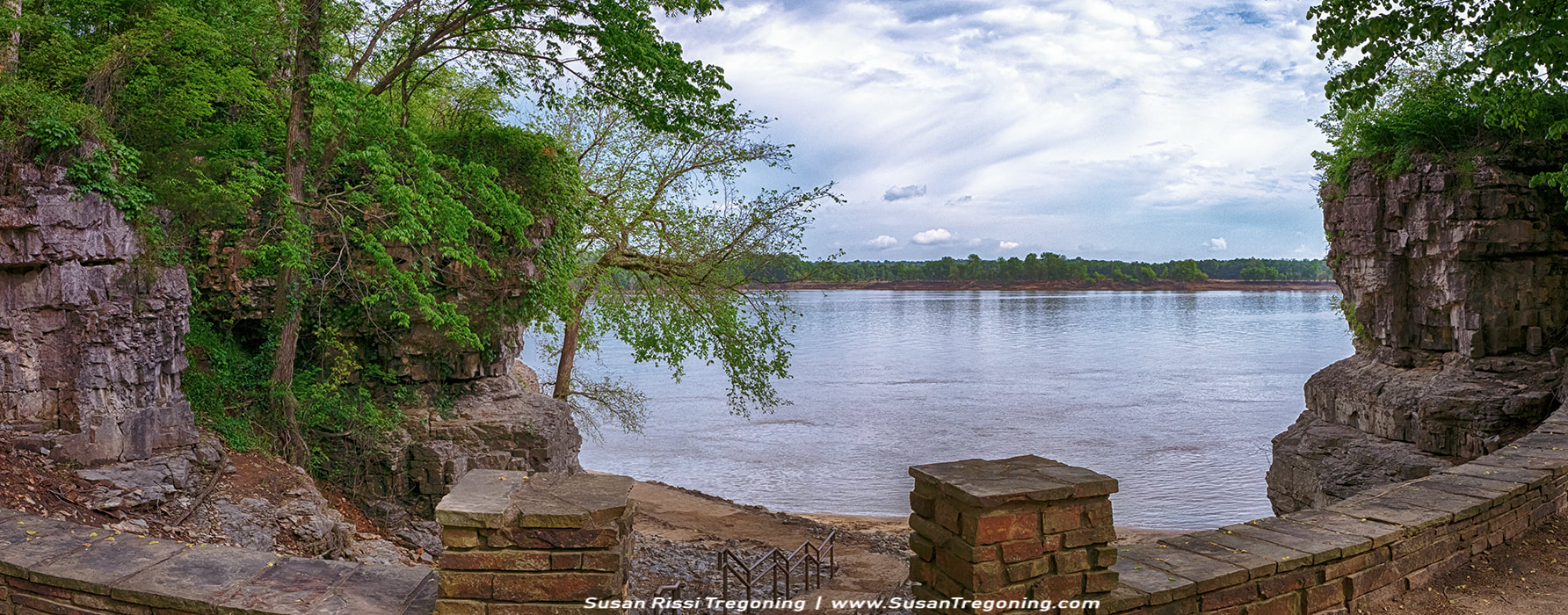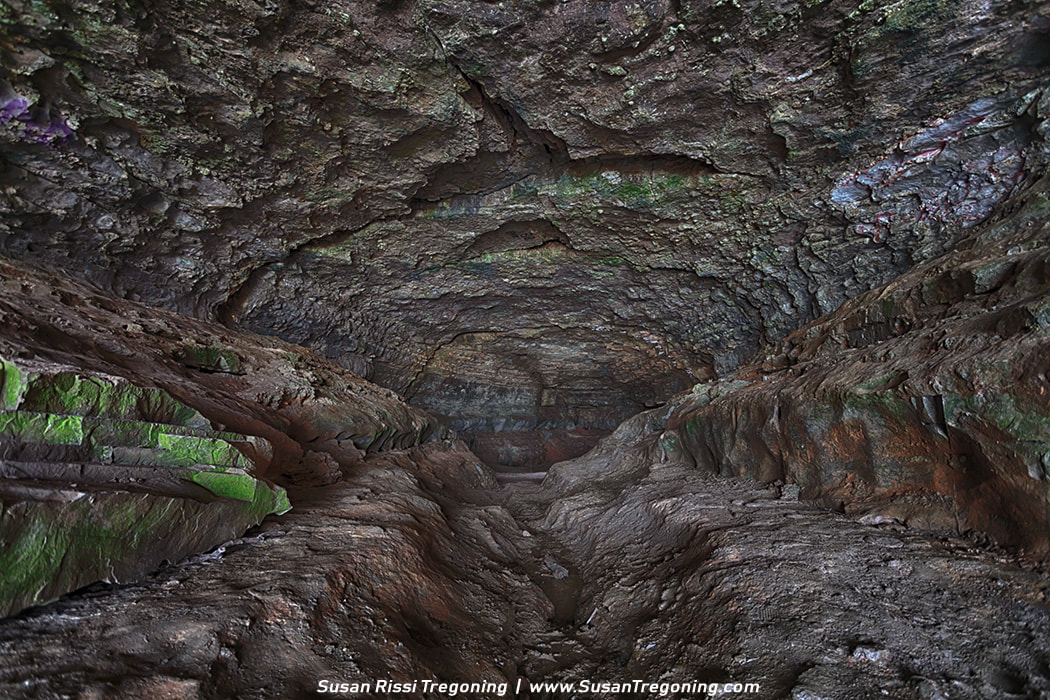|
Sitting along the banks of the Ohio River in a quiet little town in southern Illinois is a cave called Cave-In-Rock. The first recorded history of Cave-In-Rock was in 1739 by French explorer M. DeLery who mapped the limestone cave and named it, “caverne dans Le Roc” which after being translated into English is still the name it bears today. Although, much of its history is unsubstantiated, the local folklore that surrounds this cave started almost immediately after its discovery and tells a story of river boat pirates, bandits, fugitives, and murderers.
The most famous of these criminals and the only story that can be verified through historical records is that of Samuel Mason. It is said that around 1797, Mason used the cave as the headquarters for the Mason Gang which was a group of ruthless river pirates and highwaymen.
Samuel Mason was a Revolutionary War officer who fought in the back country against the Indians. Always a bad guy, he got into trouble with the law in Knoxville, Tennessee for robbing people. When he was run out of town there, he moved his gang to Henderson, Kentucky where they ended up killing the local constable. Once again run out of town, the Mason Gang eventually made their way to Cave-In-Rock.
In the words of Illinois historian John W. Allen:
Today only the natural beauty of the historic spot remains, clothed in mystery. In the hollow silence of the cave that echoes the peaceful cooing of doves, a visitor can let a vivid imagination run riot.
The legend states that, Mason used the cavern as a tavern which created an easy lure for weary travelers as they passed by. It was a combination of gambling den, brothel and refuge for criminals; but, according to Dr. Mark Wagner, interim director and staff archaeologist of Southern Illinois University at Carbondale’s Center for Archaeological Investigations, Mason and his gang only stayed in Cave-In-Rock for about six months. At the time, the Ohio River was like a busy interstate highway making it far too dangerous for the Mason gang to work from one location where they could easily be found by the law. While there might have been a tavern there at the time it is unconfirmed that Samuel Mason ran it. It is more likely that the gang actually moved through the woods creating temporary camps along the way and attacking flat boats along the Ohio River as they went.
Moving on, Mason’s gang eventually made it down into Arkansas and the Mississippi River Valley, which was still Spanish Territory at the time. It is in Arkansas that they were finally captured. When asked by the Spanish if he was a pirate, Mason claimed he was just a farmer and that he and his family wanted to put down roots in Arkansas. He and the gang were finally arrested because the Spanish found 20 human scalps in his baggage. Mason never went to trial, he was shot in the head during an escape attempt. Wounded, he still managed to get away. Some of this gang later turned in his severed head to Spanish authorities where they were arrested and stood trial. It is unknown, if Mason died from the bullet wound or if his gang turned on him and murdered him.
It was because of these arrests and the subsequent trial transcripts of the gang members that there is any historical documentation that tells the story of Mason’s time in Cave-In-Rock. Newspapers ran wild with the story of Samuel Mason and his gang, building up Cave-In-Rock’s reputation as a den of piracy and bandits and making Mason infamous. Although Mason died in 1803, it wasn’t until the 1820s that Mason’s infamy had faded from local memory and he was no longer blamed for all criminal activity in the area.
Other famed criminals said to have hidden out in the caves are the Harpe brothers, who are consider America’s first serial killers due to a spate of murders they embarked on in 1798. The Harpe Brothers didn’t choose their victims; they simply killed anyone and everyone who got in their way…men, women, and children.
In the early 1800s, the Sturdivant Gang and the Ford’s Ferry Gang are said to have made appearances in the region. The Sturdivant Gang originated from Colonial Connecticut and their leader, Roswell S. Sturdivant, was a third generation counterfeiter. The Sturdivant Gang mostly hung around St. Clair County, Illinois but also had a fortress in Pope County. Ford’s Ferry Gang was more local. James Ford, the leader was a business and community leader in both Kentucky and Southern Illinois few knew of his dual personality as a gang leader of a group of thugs that high jacked flatboats for several decades.
More local legend places Jesse James and his gang here, as well.
Finally in an effort to clean out the cave, a group of justice minded vigilantes known as “The Exterminators” raided the cave and surrounding area, effectively destroying the criminal activity in the area. After that, more bandits moved in but none ever stayed for long.
In 1816, the earliest known permanent white settlers arrived and started building a town near the cave. It is said that during this time the cave was even used as a church. In 1929, the State of Illinois acquired 64.5 acres above the cave for a park. They have since increased it to 204 acres. The well-wooded, 60-foot-high hills and the rugged bluffs along the river command expansive views of the Ohio River. It was named Cave-In-Rock State Park.
Cave In Rock State Park in located in Hardin County, Illinois at 1 New State Park Rd, Cave-In-Rock, IL 62919.
It is one of the stops in the Illinois portion of the Ohio River Scenic Byway.
More images of Illinois can be found in my Illinois Gallery.
See an image you like? You can purchase Susan's work in The Art Gallery.
All images in the her collection are available as wall art, fine art prints, on home decor, gift items and apparel.
4 Comments
Kenneth Ashcraft
5/7/2019 05:16:41 pm
Where is this?
Reply
Susan Tregoning
5/7/2019 05:36:53 pm
Hi Kenneth, Cave-In-Rock, IL is on the southeastern side of the state, almost at the tip. If you plan to visit, you'll need to wait for a drier time, I'm sure it's completely underwater at the moment.
Reply
Dennis Kaegi
2/14/2022 06:49:28 pm
Historians doubt the Cave was ever a long-term home for criminals. Apparently, they do not realize the Ohio River floods the cave annually or more frequently, thus, driving out any inhabitants for a while. The flooding also explains the numerous old dates cut into the cave ceiling where boats could reach during floods.
Reply
2/15/2022 03:42:12 pm
Very true! I grew up just a couple hours from Cave In Rock and have made many many trips to the cave but I have only been inside a handful of times since it's usually flooded.
Reply
Your comment will be posted after it is approved.
Leave a Reply. |
AuthorI am the 8th photographer in 4 generations of my family. Back in 2006, my husband accepted a job traveling, and I jumped at the chance to go with him. Categories
All
Archives
June 2024
This website uses marketing and tracking technologies. Opting out of this will opt you out of all cookies, except for those needed to run the website. Note that some products may not work as well without tracking cookies. Opt Out of Cookies |










 RSS Feed
RSS Feed